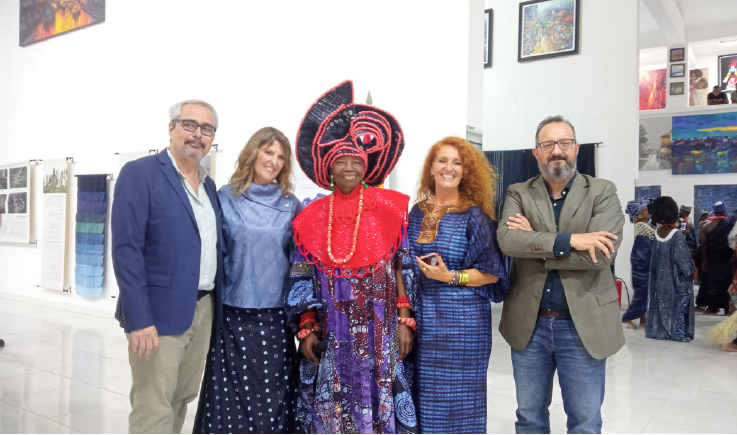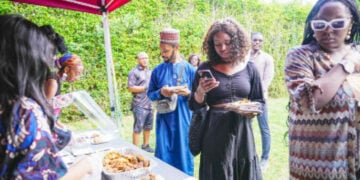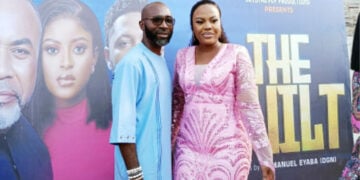On July 5, 2024, the exhibition Blue Africa: Stories Woven In Indigo, opened at the Nike Art Gallery in Abuja, Nigeria. Curated by a Spanish Gallery, MAMAH Africa with the support of the Spanish Embassy Nigeria, Spanish Museum of Anthropology and the Ministry of Arts, Culture and Creative Economy
Nigeria, it featured Indigo-dyed textiles from five West African countries, including Nigeria, Burkina Faso, Cote d’Ivoire, Guinea Conakry, and Mali. The exhibition aims at highlighting, celebration and preservation of these fabrics, with emphasis on the latter.
While Africa is popular for Indigo (blue) dyeing, with the National Gallery of UK dating first slave indigo plantation in present day Liberia between the 16th to 19th century, the traditional culture and techniques of Indigo dyeing is somewhat on the extinct, overtaken by synthetic dyes. This means loss of cultural heritage and values, and loss of livelihoods of the local women who depend on these Textile-making value-chain for survival.
Blue Africa highlights the role of Indigo-dyed textiles in the preservation of our cultural heritage and values, as well as the need to ensure passage of these knowledge to the future generation, through the division of the exhibition in three parts. First, the display of textiles curated by MAMAH Africa’s Laura de la Carrera, the contemporary African pieces designed by the gallery’s Maica de la Carrera (and Nike Gallery apprentices), and the photographed canvases of Indigo textiles by Kim Manresa, accompanied by the curator’s notes. Each country section displays the three aforementioned categories.
The texts drafted by Laura interpret the meanings of the designs on each fabric and its relation and relevance in the countries’ cultures. The fashion pieces of simple yet elegant cuts were designed to adapt to the Spanish female bodies and sizes, with respect to the readings, designs and meaning behind each fabric.
Popularly referred to as Adire (printed Indigo-dyed fabrics) or Amure (Indigo-only dyed fabrics without design) the textile is largely found amongst the Yoruba dominated south-west of Nigeria. However, it is also found in northern part of Nigeria, in Kano, and dubbed Ukara in the south-east of Nigeria, with Nsibidi symbolic writing designs.
In the other exhibited countries, it is known as the Faso Dan Fani – translated as ‘Cloth Woven in the Homeland’ (Burkina Faso). It represents the badge and bulwark of the Burkinabe culture; the Baoule in Cote d’Ivoire, distinguished for its embroidered coloured rectangles, which is a testament of its adaptability over time; the Lepi (Bazin-dyed fabric) in Guinea Conakry symbolizing the values and cultures of the Futa Yallon, Fulani people in Labe, and the main source of income for their women; and Dogon/Puel in Mali, representing Dogon peoples’ complex worldview, specific beliefs and rituals.
Generally, Indigo textiles are largely made of cotton (oftentimes handwoven), but are occasionally made of handwoven silk, a combo of cotton and handwoven silk, or consisting of silk and synthetic thread.
While there are deliberate steps to preserve and transfer traditional knowledge or processes of Indigo textiles such as the cooperatives in Cote d’Ivoire; the three-step (sewing, printing and dyeing) apprenticeship system in Mali, and the master/workshop classes of Nike Art Gallery, Nigeria, these efforts are majorly private-sector-driven, particularly by cash-strapped galleries or associations. This is where government support is crucial, like it was in hosting this exhibition in Nigeria which initially premiered in Spain in 2023, with the expectation of traveling to the other exhibited countries.
“We spent many years in Senegal and discovered that the Indigo technique in some way is going extinct because these traditional technique in Senegal is not well known. We have been focusing on trying to find the right masters to teach a group of women who work in the clothes market in Dakar, the indigo techniques.
“We are a very small cultural association, working with the Spanish museum and the ministry of culture in Nigeria to achieve this together with Mama Nike. The support of ministries of culture of every country, and the support of cultural exchanges between African and European countries like Spain will help in the preservation of Africa’s Indigo Textile heritage,” said MAMAH Curator, Ricardo Alvarez.
Amounting to a year’s worth of preparation, and 25 years in the collation its richly diverse fabrics, MAMAH Africa isn’t in a hurry to leave West Africa, and expects to feature more countries within and outside of West Africa in future exhibitions.
“We are not certain yet (of the exhibition’s tour of West Africa) but we will be delighted if it happens. On this trip, we have been gathering information from Nigerians on techniques for indigo making. In some ways it is similar to other countries, but in some ways, it is also different. This is very interesting.
“I think Africa is rich enough in Indigo for us to stay on (for years). And we have been researching indigo for 25 years just in West Africa. We will have a chance to investigate more in the north of Africa, or the East, and perhaps the south of Africa,” concluded Alvarez.
Blue Africa: Stories Woven In Indigo opened July 5 through August 4, 2024 at the Nike Art Gallery and Foundation, Abuja, Nigeria.





